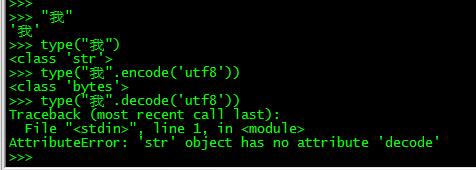实现类似tail -f file功能
python版本py3
tail -f file是打印最后10行,然后跟踪文件追加的内容打印出来。
python3 以为本方式打开的话,不能回退(f.seek(-1,1)),所有以'rb'方式打开文件。
思路是f.seek(-n,2)从文件末尾回退n字节,然后f.readlines()读取文件,如果读到的少于10行,则再往前移动n字节,直到读到11行,然后打印出来,再跟踪打印文件追加的内容,并打印。
知识点:
f.tell()返回当前的文件位置
f.seek(n,m),m=0从文件开头往前或往后移到n字节,负数表示像文件头方向移动,正数表示向文件尾移动,m=1表示从文件指针当前位置移动,m=2表示从文件末尾开始移动,指针超出边界会报错。
f.seek(0,2)移到文件末尾
open(file,'r')以文本方式打开,open(file,'rb')以二进制方式打开。
由于文档是utf8或gbk编码保存的文件,以二进制方式打开文件读取到的是uft8或gbk编码(字节),所有打印是需要解码。
个人觉得在py2中,
"我”是str类型,utf8或gbk编码保存在内存中,只能进行解码成unicode操作:

py3中
‘我’是str类型,以unicode编码放在内存中,只能解码成bytes操作:

具体代码实现:
1 #! -*- coding:utf-8 -*- 2 # runing on python3 3 import os,sys 4 from time import sleep 5 COUDING=sys.getfilesystemencoding() 6 7 class tail(object): 8 9 def __init__(self,n,filename,callback): 10 self._n = n 11 self.filename= filename 12 self.callback = callback 13 self.track() 14 15 def track(self): 16 if os.path.exists(self.filename): 17 if os.path.isfile(self.filename): 18 try: 19 with open(self.filename,'rb') as f: 20 self._file = f 21 # 文件内部指针移到末尾 22 f.seek(0, os.SEEK_END) 23 self._len = f.tell() 24 self.showline() 25 while True: 26 line = f.readline() 27 self.callback(line) 28 sleep(0.5) 29 except Exception as e: 30 print(e) 31 else: 32 sys.stdout.write("tail: %s: cannot follow end of this type of file; giving up on this name"%self.filename) 33 else: 34 sys.stdout.write("tail: cannot open `%s' for reading: No such file or directory"%self.filename) 35 36 def showline(self): 37 # 假设每行100个字节 38 line_len = 100 39 n = self._n 40 # 文件字节数小于500,直接从头读文件,然后取后5行 41 if self._len < n * line_len: 42 self._file.seek(0) 43 lines = self._file.readlines()[-self._n:] 44 self.callback(lines) 45 else: 46 # 指针总文件末尾往文件头移动n * line-len个字节 47 while True: 48 self._file.seek(-n*line_len,os.SEEK_END) 49 lines = self._file.readlines() 50 # 读n+1行,因为seek是以字节为单位移到的,如果移到一个中文字符的编码的中间,会出现UnicodeDecodeError: 'utf-8' codec can't decode byte 0x80 in position 0: invalid start byte 51 if len(lines) > self._n: 52 self.callback(lines[-self._n:]) 53 return 54 else: 55 n += 1 56 57 def printline(lines): 58 if isinstance(lines,list): 59 for line in lines: 60 sys.stdout.write(line.decode(COUDING)) 61 elif isinstance(lines,bytes): 62 sys.stdout.write(lines.decode(COUDING)) 63 64 if __name__ == "__main__": 65 if len(sys.argv) < 2: 66 print("xxx") 67 else: 68 # 可加参数解析模块来获取文件名和显示最后多少行 69 tail(10,sys.argv[1],printline)




【推荐】还在用 ECharts 开发大屏?试试这款永久免费的开源 BI 工具!
【推荐】国内首个AI IDE,深度理解中文开发场景,立即下载体验Trae
【推荐】编程新体验,更懂你的AI,立即体验豆包MarsCode编程助手
【推荐】轻量又高性能的 SSH 工具 IShell:AI 加持,快人一步